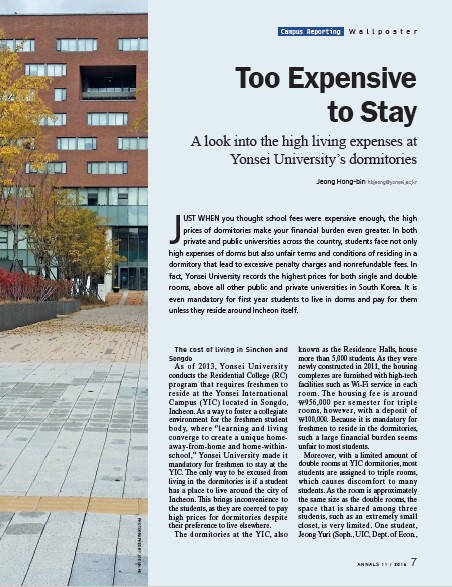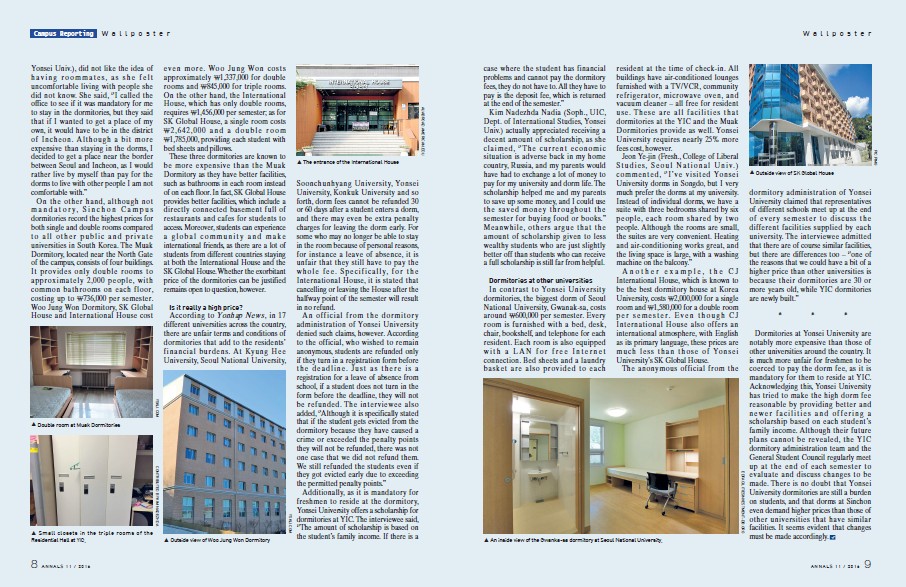A look into the high living expenses at Yonsei University’s dormitories


JUST WHEN you thought school fees were expensive enough, the high prices of dormitories make your financial burden even greater. In both private and public universities across the country, students face not only high expenses of dorms but also unfair terms and conditions of residing in a dormitory that lead to excessive penalty charges and nonrefundable fees. In fact, Yonsei University records the highest prices for both single and double rooms, above all other public and private universities in South Korea. It is even mandatory for first year students to live in dorms and pay for them unless they reside around Incheon itself.
The cost of living in Sinchon and Songdo
As of 2013, Yonsei University conducts the Residential College (RC) program that requires freshmen to reside at the Yonsei International Campus (YIC) located in Songdo, Incheon. As a way to foster a collegiate environment for the freshmen student body, where “learning and living converge to create a unique home-away-from-home and home-within-school,” Yonsei University made it mandatory for freshmen to stay at the YIC. The only way to be excused from living in the dormitories is if a student has a place to live around the city of Incheon. This brings inconvenience to the students, as they are coerced to pay high prices for dormitories despite their preference to live elsewhere.
The dormitories at the YIC, also known as the Residence Halls, house more than 5,000 students. As they were newly constructed in 2011, the housing complexes are furnished with high-tech facilities such as Wi-Fi service in each room. The housing fee is around ₩956,000 per semester for triple rooms, however, with a deposit of ₩100,000. Because it is mandatory for freshmen to reside in the dormitories, such a large financial burden seems unfair to most students.
Moreover, with a limited amount of double rooms at YIC dormitories, most students are assigned to triple rooms, which causes discomfortto many students. As the room is approximately the same size as the double rooms, the space that is shared among three students, such as an extremely small closet, is very limited. One student, Jeong Yuri (Soph., UIC, Dept. of Econ., Yonsei Univ.), did not like the idea of having roommates, as she felt uncomfortable living with people she did not know. She said, “I called the office to see if it was mandatory for me to stay in the dormitories, but they said that if I wanted to get a place of my own, it would have to be in the district of Incheon. Although a bit more expensive than staying in the dorms, I decided to get a place near the border between Seoul and Incheon, as I would rather live by myself than pay for the dorms to live with other people I am not comfortable with.”
On the other hand, although not mandatory, Sinchon Campus dormitories record the highest prices for both single and double rooms compared to all other public and private universities in South Korea. The MuakDormitory, located near the North Gate of the campus, consists of four buildings.It provides only doublerooms to approximately 2,000 people, with common bathrooms on each floor, costing up to₩736,000 per semester. Woo Jung Won Dormitory, SK Global House and International House cost even more. Woo Jung Won costs approximately ₩1,337,000 for double rooms and ₩845,000 for triple rooms. On the other hand, the International House, which has only double rooms, requires ₩1,456,000 per semester; as for SK Global House, a single room costs ₩2,642,000 and a double room ₩1,785,000,providing each student with bed sheets and pillows.
These three dormitoriesare known to be more expensive than the Muak Dormitory as they have better facilities, such as bathrooms in each room instead of on each floor. In fact, SK Global House provides better facilities, which include a directly connected basement full of restaurants and cafes for students to access. Moreover, students can experience a global community and make international friends, as there are a lot of students from different countries staying at both the International House and the SK Global House. Whether the exorbitant price of the dormitories can be justified remains open to question, however.
Is it really a high price?
According to Yonhap News, in 17 different universitiesacross the country, there are unfair terms and conditions of dormitories that add to the residents’ financial burdens. At Kyung Hee University, SeoulNational University, Soonchunhyang University, Yonsei University, Konkuk University and so forth, dorm fees cannot be refunded 30 or 60 days after a student enters a dorm, and there may even be extra penalty charges for leaving the dorm early. For some who may no longer be able to stay in the room because of personal reasons, for instance a leave of absence, it is unfair that they still have to pay the whole fee. Specifically, for the International House, it is stated that cancelling or leaving the House after the halfway point of the semester will result in no refund.
An official from the dormitory administration of Yonsei University denied such claims, however. According to the official, who wished to remain anonymous, students are refunded only if they turn in a registration form before the deadline. Just as there is a registration for a leave of absencefrom school, if a student does not turn in the form before the deadline, they will not be refunded. The interviewee also added, “Although it is specifically stated that if the student gets evicted from the dormitory because they have caused a crime or exceeded the penalty points they will not be refunded, there was not one case that we did not refund them. We still refunded the students even if they got evicted early due to exceeding the permitted penaltypoints.”
Additionally, as it is mandatory for freshmen to reside at the dormitory, Yonsei University offers a scholarshipfor dormitories at YIC. The interviewee said, “The amount of scholarship is based on the student’s family income. If there is a case where the student has financial problems and cannot pay the dormitory fees, they do not have to. All they have to pay is the deposit fee, which is returned at the end of the semester.”
Kim Nadezhda Nadia (Soph., UIC, Dept. of International Studies, Yonsei Univ.) actually appreciated receiving a decent amount of scholarship, as she claimed, “The current economic situation is adverse back in my home country, Russia, and my parents would have had to exchange a lot of money to pay for my university and dorm life. The scholarship helped me and my parents to save up some money, and I could use the saved money throughout the semester for buying food or books.” Meanwhile, others argue that the amount of scholarship given to less wealthy students who are just slightly better off than students who can receive a full scholarship is still far from helpful.
Dormitories at other universities
In contrast to Yonsei University dormitories, the biggest dorm of Seoul National University, Gwanak-sa, costs around ₩600,000 per semester. Every room is furnished with a bed, desk, chair, bookshelf, and telephone for each resident. Each room is also equipped with a LAN for free Internet connection. Bed sheets and a laundry basket are also provided to each resident at the time of check-in. All buildings have air-conditioned lounges furnished with a TV/VCR, community refrigerator, microwave oven, and vacuum cleaner – all free for resident use. These are all facilities that dormitories at the YIC and the Muak Dormitories provide as well. Yonsei University requires nearly 25%more fees cost, however.
Jeon Ye-jin (Fresh., College of Liberal Studies, Seoul National Univ.) commented, “I’ve visited Yonsei University dorms in Songdo, but I very much prefer the dorms at my university. Instead of individual dorms, we have a suite with three bedrooms shared by six people, each room shared by two people. Although the rooms are small, the suites are very convenient. Heating and air-conditioning works great, and the living space is large, with a washing machine on the balcony.”
Another example, the CJ International House, which is known to be the best dormitory house at Korea University, costs ₩2,000,000 for a single room and ₩1,580,000 for a double room per semester. Even though CJ International House also offers an international atmosphere, with English as its primary language, these prices are much less than those of Yonsei University’s SK Global House.
The anonymous official from the dormitory administration of Yonsei University claimed that representatives of different schools meet up at the end of every semester to discuss the different facilities supplied by each university. The interviewee admitted that there are of course similar facilities, but there are differences too – “one of the reasons that we could have a bit of a higher price than other universities is because their dormitories are 30 or more years old, while YIC dormitories are newly built.”
* * *
Dormitories at Yonsei University are notably more expensive than those of other universities around the country. It is much more unfair for freshmen to be coerced to pay the dorm fee, as it is mandatory for them to reside at YIC. Acknowledging this, Yonsei University has tried to make the high dorm fee reasonable by providing better and newer facilities and offering a scholarship based on each student’s family income. Although their future plans cannot be revealed, the YIC dormitory administration team and the General Student Council regularly meet up at the end of each semester to evaluate and discuss changes to be made. There is no doubt that Yonsei University dormitories are still a burden on students, and that dorms at Sinchon even demand higher prices than those of other universities that have similar facilities. It seems evident that changes must be made accordingly.
Jeong Hong-bin
hbjeong@yonsei.ac.kr

